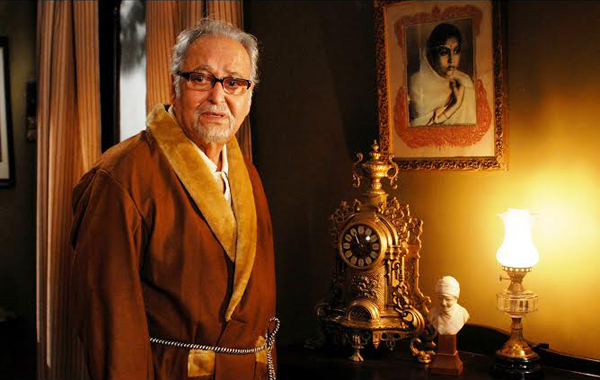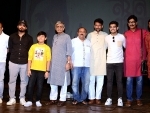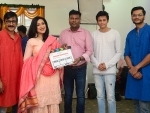
Age bows to his talent
Remember the shy husband Apu as he introduces his new bride (Sharmila Tagore) from a rich family in the village to his modest flat in the city in Satyajit Ray’s Apur Sansar (1959)? That was Soumitra Chatterjee’s debut role. Today more than five decades later, having acted in 400 plus films and numerous awards in his kitty, he is as versatile as ever, as also in demand. Two documentaries have been made on him He won 'Officier des Arts et Metiers', the highest award for arts given by the French government, and a lifetime achievement award from Italy.
Chatterjee has aged gracefully and the roles that come to him suit his personality. Few know that before his debut in the maestro’s film, he was rejected for the title role of Bengali film Neelachale Mahaprabhu. “I went for the audition reluctantly because in those days, having nourished myself on films like Bicycle Thieves, Miracle in Milan,Fall of Berlin, etc. I had an extremely snobbish attitude towards Bengali and Indian cinema. Remember, Apur Sansar was yet to happen. I failed the screen test, of course. Believe me, it was a great relief because they had told me that I would have to shave my head if finalised for the title role! “
There is interesting footnote to it. “Several years later, when I was travelling with Manik-da (Satyajit Ray) to Delhi to pick the President’s award, we met the producer ofNeelachale Mahaprabhu. He proudly told Manik-da, ‘I was the one who discovered Soumitra Chatterjee.’ Manik-da knew the whole story and countered, ‘but you had rejected him’.” Chatterjee chuckles at the memory of the crestfallen producer.
Pather Panchali , Ray’s first film (1955) changed Chatterjee’s entire perspective about Indian cinema. He recalls: “It had already created a stir among the Bengali intelligentsia while in production. I came into the scene quite accidentally. A crew member from Ray’s team spotted me outside the [iconic] Coffee House on College Street one day. They were scouting for someone to play Apu in Aparajita, the second in the Apu trilogy. Ray took one look at me and decided I was too tall for Apu. But he had earmarked me for Apur Sansar. Later, he made me go through a camera test and a voice test though he had already decided that I would play Apu in the film. The entire rigmarole was to strip me of camera consciousness.”
It was the time when Uttam Kumar was ruling the Bengali cinema scene. About his relationship with the senior actor, he reminisces, “Working with Uttam Kumar didn’t intimidate me because we shared a close family bond. I had seen him first at my sister’s wedding. Working together for the first time in Tapan Sinha’s Jhinder Bandi(1961) only strengthened the friendship.”
He admits that at times there were disagreements between them but basically, “He was like my elder brother. He gave me a tremendous sense of competition. I had to deal with it on my own terms, without either imitating him, or being influenced by him. We were more like the traditional rivals East Bengal and Mohan Bagan football clubs. Kolkata would be divided into two warring groups when it came to choosing between the two of us. Well, I did have my box office potential as a hero. I won’t have lasted this long if I did not.”
Chatterjee is well-known for his excellent recitation of poetry and he writes poetry too. Around a dozen books of his work have been published. He also co-edited a famous literary journal called Ekhhon for a long time.
Being in the Kolkata performing scene how can he not be involved in theatre? Chatterjee has directed and acted and even translated (a few) more than a dozen significant plays. Raja Lear, a translated version of Shakespeare’s King Lear drew packed houses when performed . In 2011, he wrote, directed and acted in Prachya’sTritiyo Onko Otoeb (The Third Act, Therefore), an autobiographical production. The play maps the personal and socio- political journey of his life. At that time he was suffering from cancer but he presented his autobiography as a stage performance nonetheless.
Strangely, he does not seem interested in directing films like many veteran actors. Why? “I enjoy directing theatre. Directing a play needs around one month to 45 days of intense rehearsals. The first fifteen days are not very demanding. It’s possible to get together in the evenings after a day of shooting. But if I were to direct a film, I would have to forget everything for around eight to nine months and work on a single film alone. Burdened with family responsibilities, this was not viable. Now, I am no longer interested.”
About the difference between acting in films and theatre , Chatterjee observes : “There are no rehearsals for cinema. So, it’s very important that the actor prepares for his role through discussions with the director, by reading and re-reading the script. Ray had given me a three-page sketch of his own conception of Apu as a character. He had asked me to read the original novel by Bibhuti Bhushan Bandopadhyay which I did.”
However, he prefers reading the screenplay because the screenplay always differs from the original. He does not like to be conditioned by preconceived notions of the character imbibed from the original story.
Chatterjee finds acting on the stage more challenging and more dynamic than acting in films. Elaborating the difference, he explains, “Acting in theatre is acting in real time. It is continuous, sequential, and chronological. The rehearsals for a play take care of the actor’s preparation for his role. The response too, is immediate. Acting in cinema is not so. Rehearsals are absent too. You can’t improvise on a performance once the final shot is taken, and it doesn’t give the actor a second chance to improve upon his work.”
Age, he believes, is no constraint for an actor. “When working with young directors, I function with them on the same platform so that they don’t feel uncomfortable working with me. Did age come in the way of the greatest actor of all time – Charlie Chaplin? The biggest actors in course of time also become the greatest stars and age is not a factor. I do admit that I tire easily these days. But I continue to work, to act and life goes on,” he sums up.
(Shoma A. Chatterji is an award-winning film critic)
Support Our Journalism
We cannot do without you.. your contribution supports unbiased journalism
IBNS is not driven by any ism- not wokeism, not racism, not skewed secularism, not hyper right-wing or left liberal ideals, nor by any hardline religious beliefs or hyper nationalism. We want to serve you good old objective news, as they are. We do not judge or preach. We let people decide for themselves. We only try to present factual and well-sourced news.






